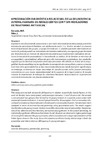Please use this identifier to cite or link to this item:
https://accedacris.ulpgc.es/jspui/handle/10553/10837
| DC Field | Value | Language |
|---|---|---|
| dc.contributor.author | Sorando, M.R. | en_US |
| dc.contributor.author | Niño, J. | en_US |
| dc.date.accessioned | 2013-10-22T05:00:09Z | - |
| dc.date.accessioned | 2018-03-15T14:25:45Z | - |
| dc.date.available | 2013-10-22T05:00:09Z | - |
| dc.date.available | 2018-03-15T14:25:45Z | - |
| dc.date.issued | 2013 | en_US |
| dc.identifier.issn | 2013-7316 | en_US |
| dc.identifier.uri | https://accedacris.ulpgc.es/handle/10553/10837 | - |
| dc.description.abstract | El presente estudio pretende aproximarse a una visión relacional de la delincuencia juvenil. En este estudio participan 45 familias, con adolescentes entre 15 y 19 años de edad. La muestra está compuesta por dos grupos, un grupo formado por 15 jóvenes que están internados en un centro de justicia juvenil con indicadores de trastorno antisocial y un segundo grupo formado por 30 jóvenes de un instituto de educación secundaria que no presentan indicadores de trastorno antisocial de la personalidad. Se ha realizado un análisis de las familias en términos de conyugalidad y parentalidad, utilizando para ello instrumentos cuantitativos. Los resultados sugieren que las familias con jóvenes internados presentan dificultades en el área de la conyugalidad siendo estadísticamente significativa la percepción de menos afecto y menor armonía. En el área de la parentalidad no se han encontrado diferencias estadísticamente significativas, sin embargo, se observa un mayor porcentaje de vínculo ausente en los jóvenes internados, coincidente con una mayor representatividad de la ausencia de la figura paterna. El estudio muestra la importancia de trabajar las relaciones familiares básicas tanto en la prevención como en la intervención con jóvenes adolescentes. | en_US |
| dc.description.abstract | This study aims to look at juvenile delinquency in relation to particular family factors. In this work 45 families have participated, with teenagers between 15 and 19 years old. The sample is comprised of two groups: One formed by 15 young inmates in a juvenile justice center with antisocial disorder indicators. A second group formed by 30 youngsters from a secondary educational institution without indicators of antisocial or personality disorder. Families have been analyzed in terms of partnership and parenting using quantitative tools. The results suggest that families with young inmate children have difficulties in the area of partnership. The perception of less affection and less harmony are statistically significant. In the area of parenting, no statistically significant differences have been found, however we observed a higher percentage of missing links between the young inmates, which coincided with a larger representation of the father figure absence. The study shows the importance of basic family relationships in both the prevention and intervention on delinquency in young teenagers. | en_US |
| dc.format | application/pdf | es |
| dc.language | spa | en_US |
| dc.relation.ispartof | IPSE-ds. Revista de Intervención Psicosocioeducativa en la desadaptación social | en_US |
| dc.source | IPSE-ds. Revista de Intervención Psicosocioeducativa en la desadaptación social. Las Palmas de Gran Canaria : Universidad de Las Palmas de Gran Canaria, Departamento de Educación, 2008-. -- [ISSN: 2013-7316] (edición en línea).-- v. 6, p. 69 | en_US |
| dc.subject | 61 Psicología | en_US |
| dc.subject | 6102 Psicología del niño y del adolescente | en_US |
| dc.subject | 6104 Psicopedagogía | en_US |
| dc.subject | 531204 Educación | en_US |
| dc.subject.other | Delincuencia juvenil | en_US |
| dc.subject.other | Conyugalidad | en_US |
| dc.subject.other | Parentalidad | en_US |
| dc.subject.other | Juvenile delinquency | en_US |
| dc.subject.other | Partnership | en_US |
| dc.subject.other | Parenting | en_US |
| dc.title | Aproximación diagnóstica relacional de la delincuencia juvenil: familias de adolescentes con y sin indicadores de trastorno antisocial | en_US |
| dc.type | info:eu-repo/semantics/article | en_US |
| dc.type | Article | en_US |
| dc.compliance.driver | 1 | es |
| dc.identifier.absysnet | 555289 | - |
| dc.investigacion | Artes y Humanidades | en_US |
| dc.rights.accessrights | info:eu-repo/semantics/openAccess | es |
| dc.type2 | Artículo | en_US |
| dc.identifier.ulpgc | Sí | es |
| item.grantfulltext | open | - |
| item.fulltext | Con texto completo | - |
| Appears in Collections: | Rev. interv. psicosocioeduc. desadapt. soc. v.6, 2013 Artículos | |
Items in accedaCRIS are protected by copyright, with all rights reserved, unless otherwise indicated.
